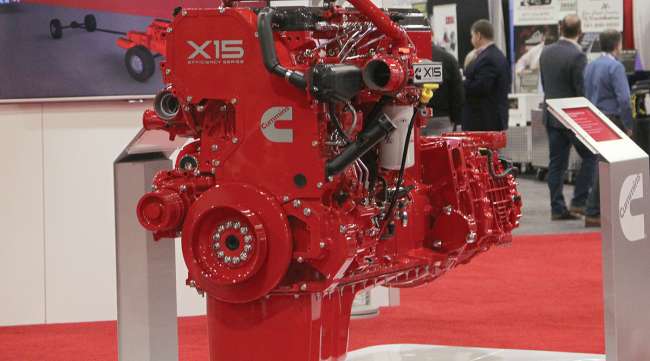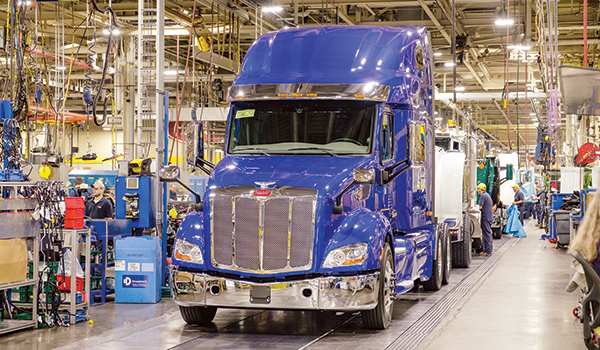Special to Transport Topics
Truck, Engine Makers Refine Products to Meet 2021 GHG Emission Standards

[Stay on top of transportation news: Get TTNews in your inbox.]
When the U.S. Environmental Protection Agency and National Highway Traffic Safety Administration in 2016 finalized the Phase 2 standards for greenhouse gas emissions and fuel efficiency for model year 2021 heavy- and medium-duty trucks, no one had a crystal ball that could predict how the market would look four years down the road.
Nonetheless, truck and engine manufacturers were quietly confident they could come up with solutions that not only comply with the regulation but save carriers money through better fuel economy, improved vehicle uptime and reduced maintenance costs.
Since then, original equipment manufacturers and engine suppliers have found a variety of ways to meet the challenges posed by the 2021 standards.
“The OEMs I’m using have done a really good job,” said Jeff Harris, vice president of maintenance for USA Truck and former chairman of American Trucking Associations’ Technology & Maintenance Council.

Home | Video | Heroes' Photo Gallery
Saluting the men and women of the trucking industry who kept America's essential goods flowing during the coronavirus pandemic.
Heroes: Peter Lacoste | Susan Dawson | James Rogers | Reggie Barrows | Kevin Cooper | Cesar Quintana Moreno
At USA Truck, Harris initially started deploying some of the first 2021-compliant trucks in 2019 while working with manufacturers to provide real-world feedback. He has settled on International and Kenworth models spec’d with a Cummins engine package paired with an Eaton transmission.
His company, like many, is transitioning to automated manual transmissions, and by the end of this trade cycle, he expects to have all but 40 of the 1,500 trucks in his fleet running with AMTs or fully automatic transmissions.
USA Truck, based in Van Buren, Ark., ranks No. 67 on the Transport Topics Top 100 list of the largest for-hire carriers in North America.
To meet the new standards, manufacturers have introduced new products with innovative power plant design and engineering solutions, and optimized engine and transmission integration for better power and fuel economy. They also added more sophisticated technologies to improve overall performance and driver support, and refined aerodynamics and other equipment specifications.
In October, Cummins announced the availability of its 2021 emission-compliant X12 and X15 series diesel engines, designed for the North American Class 8 on-highway market.

Boerger
The products were developed to address three core goals: increased uptime, better overall total cost of ownership and improved drivability, said Amy Boerger, vice president of engine business sales at Cummins.
“We found that the most effective solution to fulfilling the customer’s uptime requirements was to focus on refining and upgrading existing technologies on the engine,” she said.
Initially launching the X15 product early in 2020 “provided nearly a year’s worth of data back into the team,” Boerger said. One finding was that the X15 Efficiency Series has demonstrated up to 3.5% better fuel economy compared with the 2019 product.
The X12 and X15 Efficiency engines also offer a higher oil drain interval of 75,000 miles for operators achieving 7 or more miles per gallon. In 2021, customers averaging between 5 and 7 mpg will see their ODI with the EPA 2021 X15 Performance series engine extended by 10,000 miles. In another nod to maintenance efficiency, Cummins has aligned the service schedule for fuel filter and oil changes on the X12 and X15 series products.

Hobbs
Peter Hobbs, vice president of market development for the on-highway market segment at Daimler Trucks North America, said the 2021-compliant Detroit DD15 Gen 5 engine was significantly redesigned to offer new ratings, an all-new aftertreatment system that’s 60 pounds lighter, and other innovations to increase fuel efficiency, durability and performance. According to Hobbs, the Gen 5 engine incorporated 50% new components as it evolved from the Gen 4 model. Engineering and design improvements included increased downspeeding, better fuel mix and combustion through a redesigned 10-hole fuel injector nozzle and a new swirl piston design, and a ball bearing simple geometry turbo delivering peak power and torque without sacrificing efficiency. The result: a 2021-compliant engine with up to a 3% improvement in fuel efficiency while meeting GHG standards.
“The real important part of a vertical integration strategy is to really dial in an efficient product,” Hobbs said. “It is important that all our components work [together] to draw out all the possible efficiencies while meeting or exceeding regulatory goals.”
He also emphasized the importance of helping fleet customers assess their needs and spec components that fulfill all requirements for an integrated powertrain combination and provide the best bang for the overall truck buck.
The customer likely will have a good idea of what is needed, but Hobbs said part of DTNA’s job is “leaning on experience and making sure the customer is ordering properly, helping them understand options.”
“Ultimately, we want to deliver a product that fits hand-in-glove with their needs and is optimized for fuel efficiency and uptime,” he said.

Noonan
In developing products to meet the 2021 requirements, as well as lay the groundwork for more stringent standards that will come into play in 2024 and 2027, Navistar has marshaled the resources of its engineering teams, in collaboration with Navistar customers, and zeroed in on aerodynamics and powertrain optimization, said Michael Noonan, Navistar’s director of certification and compliance.
“We’ve worked very hard ... to improve efficiency within our powertrain options [and] to enhance the driver experience for real-world fuel economy gains,” he said.
Noonan said it is a broad yet detail-oriented effort to “ensure they are provided the right solution for the task ... all the way down to the tires they select for each order.”
What changed between the Phase 1 and Phase 2 regulations was twofold, he said: “First, the stringency of the regulation has been increased and will continue to do so through 2027,” which will require continued gains in fuel economy and GHG performance. Secondly, Noonan said, “individual powertrain selection inputs are now part of the regulatory compliance model, meaning that each individual truck will have a unique GHG signature and must be tracked,” for compliance reporting at the end of each year.
Noonan also stressed the importance of continued advances in aerodynamics, the performance of which is now a component in the GHG Phase 2 regulatory compliance model.
“Simply put, nonoptimized aerodynamics will be penalized within the regulatory compliance model,” Noonan said, adding that anyone piloting a tractor on the highway knows that “improvements in aerodynamics equal improvements in fuel efficiency and lower total cost of ownership.”
USA Truck’s Harris also emphasized the impact of refined aerodynamics, as well as the continued improvement of low-rolling-resistance drive and steer tires, and the latest “predictive” operating management technologies embedded in trucks — all of which are driving better fuel economy and lower emissions.
Data-Driven Features
Adaptive cruise control, automatic idle reduction, lane-keeping warnings and anti-rollover systems have been available for a while. Now the next generation is here.
“Predictive cruise control uses in-truck GPS coordinates coupled with terrain and road mapping to predict what’s ahead, and automatically adjusts the truck’s speed and acceleration accordingly for the road ahead and conditions” to optimize engine load and fuel efficiency, Harris said.

According to Shelley Dellinger of Cargo Transporters and Alphonso Lewis, ATA’s Road Team Captain and YRC Freight driver, diversity in recruitment methods is essential. Hear a snippet, above, and get the full program by going to RoadSigns.TTNews.com.
With the Cummins EX products, among the new predictive features that support fuel economy and drivability advantages are “on ramp boost,” which temporarily trades fuel economy for acceleration on an on ramp, allowing the driver to merge at a safer speed; “predictive engine braking,” which helps the driver maintain a safe speed on a long, steep downhill grade when heavily loaded; and “predictive gear shift,” which judges the grade ahead to help maintain speed on grade and prevent re-acceleration at the top of the hill.
All these systems take in huge chunks of real-time data, including terrain, ambient conditions, load characteristics and driver input, and use smart algorithms to support the driver and help the equipment operate as safely and efficiently as possible.
Harris predicted these features eventually will win over the more seasoned drivers.
“You still have some old school drivers who have grown up with the manual [transmission],” he said. “Some fight it tooth and nail, but by and large, once they have a month or so in a new truck, they love it.”
Tighter Integration
Mary Beth Halprin, spokesperson for Volvo Group, said the manufacturer’s North American brands, Volvo Trucks and Mack Trucks, leaned heavily on previous engineering and product development work to meet prior regulations as a baseline for its 2021-compliant products.
She cited as well the advantage of Volvo and Mack’s integrated proprietary powertrain approach, which enables the company to “more easily find and implement [upgrades and] improvements that deliver increased efficiency.”
Volvo’s VNR Electric and Mack LR Electric battery-electric vehicles also can have a big impact on greenhouse gas credits and meeting upcoming regulations.

Halprin
“Today’s trucks and their technology do require additional training, but many of these new features are intuitive or invisible in their operation, allowing experienced drivers to quickly adapt,” Halprin said.
Transmission manufacturers have been working side by side with engine and axle builders to deliver integrated powertrain solutions focused on the same end-game for fleets: efficiency, reliability, uptime and lowest total cost of ownership while meeting 2021 standards.
Allison Transmission’s Rob Merrion, managing director for mechatronics and transmission control systems, said it’s truly a partnership among truck OEMs and suppliers of engines, transmissions, axles and other components. Allison produces only fully automatic transmissions.
In developing products to meet the fuel efficiency and GHG goals, “extensive tests were simulated and completed in powertrain test cells, and in actual vehicles” on the highways, all designed to gather data and derive insights into changes, improvements or innovations needed to achieve the desired GHG results, Merrion said. The company uses its recently opened Vehicle Environmental Test Center as a controlled and repeatable environment for a multitude of testing needs, including emissions.

A Peterbilt truck coming off the assembly line at a manufacturing facility. Peterbilt Chief Engineer Scott Newhouse said most of what Peterbilt is doing is optimizing and refining systems already in the product, “so it’s no shock or surprise to the driver." (Thomas Judd for Peterbilt)
Driver Satisfaction
The GHG regulations favor automation, said Merrion, adding that automatic transmissions require less driver training, which fleets have cited as a benefit for recruiting new drivers.
“The industry continues to see a shrinking driver pool and with an Allison automatic, algorithms control the transmission to provide the right mix of performance and fuel economy,” he said.

Newhouse
At the end of the day, manufacturers are driving toward a basic objective that is unchanged, observed Scott Newhouse, chief engineer at Peterbilt Motors Co., a division of Paccar Inc.
“The goal with any regulation is to meet or exceed it,” he said, “and at the same time, provide a more fuel efficient, more cost-effective product, more reliable all the time. Those goals don’t change.”
Newhouse said it is imperative to be in tune with fleets and understand their needs and where the business is going. Manufacturers also must be especially sensitive to and aware of drivers and their life in the cab on the road. As trucks incorporate more technology and automated systems, understanding how drivers engage and interact with these systems is key.
“These are very knowledgeable and intelligent people,” Newhouse said of today’s professional truck drivers.
Newhouse noted that most of what Peterbilt is doing is optimizing and refining systems already in the product, “so it’s no shock or surprise to the driver. As long we do our job and make things as logical as possible [for the driver], things work out well.”
“You’ve got to make sure that there is a benefit, a payback, for the fleet and the business,” Newhouse said about the 2021 compliance process, “and you have to make sure the driver finds value in it and wants to use it.”
Want more news? Listen to today's daily briefing:
Subscribe: Apple Podcasts | Spotify | Amazon Alexa | Google Assistant | More




